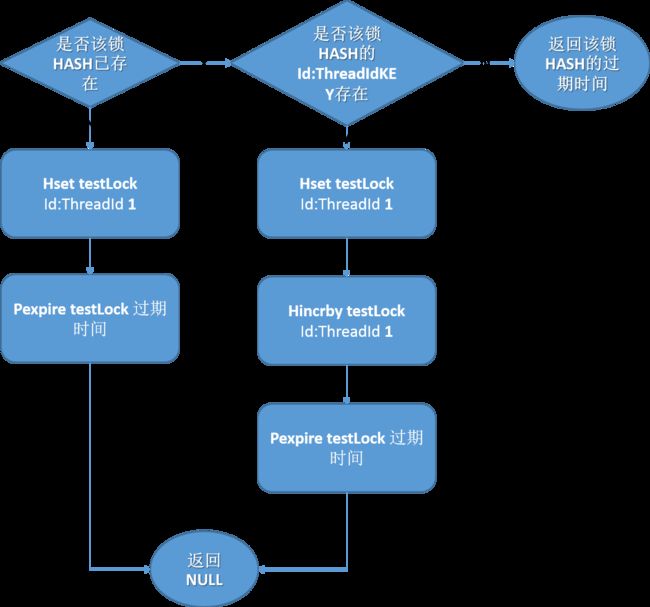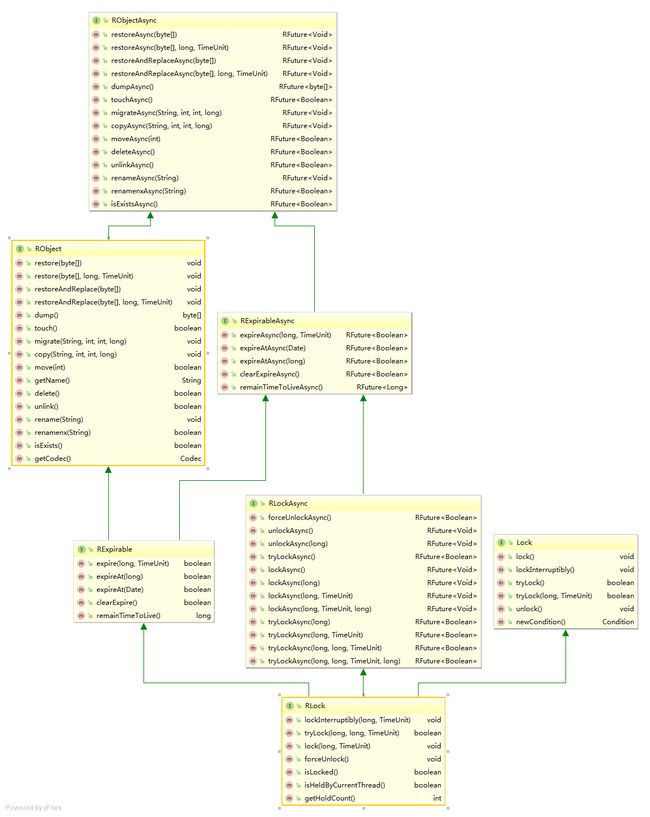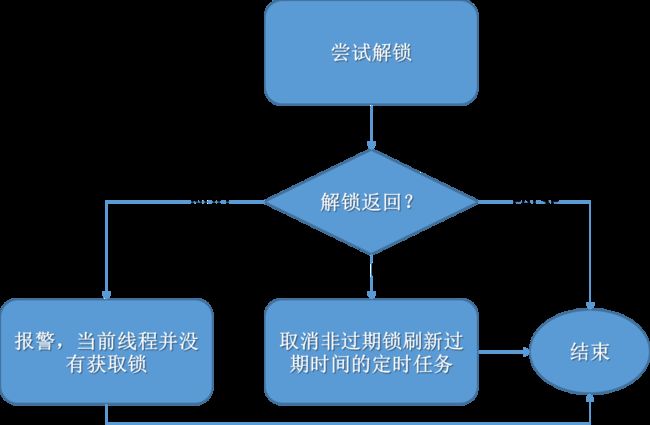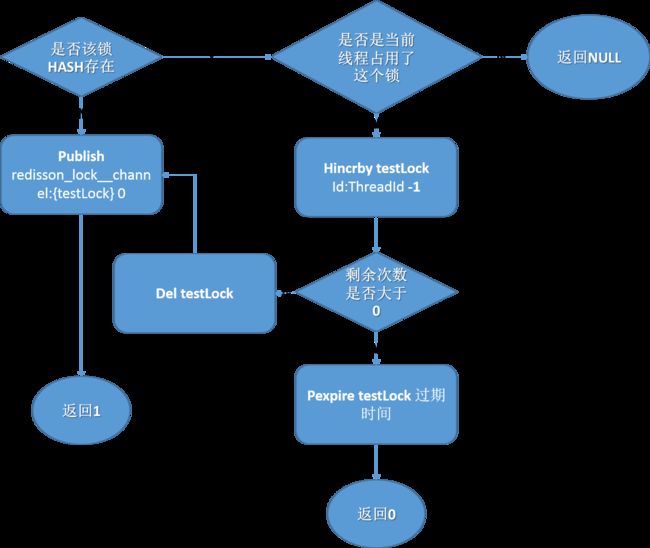Redis系列-生产应用篇-分布式锁(2)-单进程Redis分布式锁的Java实现(Redisson使用与底层实现)-可重入锁
Redisson单进程Redis分布式悲观锁的使用与实现
本文基于Redisson 3.7.5
1. 可重入锁(Reentrant Lock)
这种锁的使用方式和Java本身框架中的Reentrant Lock一模一样
RLock lock = redisson.getLock("testLock");
try{
// 1. 最常见的使用方法
//lock.lock();
// 2. 支持过期解锁功能,10秒钟以后自动解锁, 无需调用unlock方法手动解锁
//lock.lock(10, TimeUnit.SECONDS);
// 3. 尝试加锁,最多等待3秒,上锁以后10秒自动解锁
boolean res = lock.tryLock(3, 10, TimeUnit.SECONDS);
if(res){ //成功
// do your business
}
} catch (InterruptedException e) {
e.printStackTrace();
} finally {
lock.unlock();
}该接口主要继承了Lock接口还有其他Redisson, 并扩展了部分方法, 比如:boolean tryLock(long waitTime, long leaseTime, TimeUnit unit)新加入的leaseTime主要是用来设置锁的过期时间, 如果超过leaseTime还没有解锁的话, redis就强制解锁. leaseTime的默认时间是30s
redisson.getLock("anyLock");的源代码是:
@Override
public RLock getLock(String name) {
return new RedissonLock(connectionManager.getCommandExecutor(), name);
}可以看出,可重入锁的实现类就是RedissonLock。
1.1 可重入锁上锁源码
RedissonLock的主要构成:
public class RedissonLock extends RedissonExpirable implements RLock {
private static final Logger log = LoggerFactory.getLogger(RedissonLock.class);
//对于不过期的锁,redisson也会每隔一段时间设置一个默认的内部锁过期时间(就是下面的internalLockLeaseTime),这是个定时任务,只要还持有锁就会一直刷新这个过期时间,防止进程死掉后锁一直不释放
private static final ConcurrentMap expirationRenewalMap = PlatformDependent.newConcurrentHashMap();
//内部锁过期时间
protected long internalLockLeaseTime;
//UUID,在Redisson初始化的时候生成
final UUID id;
//公共PUBLISH和SUBSCRIBE消息处理类
protected static final LockPubSub PUBSUB = new LockPubSub();
//命令执行代理
final CommandAsyncExecutor commandExecutor;
public RedissonLock(CommandAsyncExecutor commandExecutor, String name) {
super(commandExecutor, name);
this.commandExecutor = commandExecutor;
this.id = commandExecutor.getConnectionManager().getId();
this.internalLockLeaseTime = commandExecutor.getConnectionManager().getCfg().getLockWatchdogTimeout();
}
//对于同一个Lock的控制Entry
protected String getEntryName() {
return id + ":" + getName();
}
//PUBLISH和SUBSCRIBE的Redis channel名称
String getChannelName() {
return prefixName("redisson_lock__channel", getName());
}
//本次锁名称,就是上锁时HASH里面的KEY
protected String getLockName(long threadId) {
return id + ":" + threadId;
}
} 在redis中的组成包括:

- 一个HASH(HASH的名字就是获取的锁的命名域,就是redisson.getLock("testLock")的参数testLock),HASH里面有一个键值对,KEY为当前上锁的唯一标识(由Redisson初始化的时候生成的全局唯一ID+当前线程ID组成,就是getLockName方法的返回)。VALUE就是上锁次数(因为可重入)。
- 一个订阅发布通道,名字是getChannelName方法的返回,这里就是就是redisson_lock__channel:{testLock}
@Override
public void lock() {
try {
lockInterruptibly();
} catch (InterruptedException e) {
Thread.currentThread().interrupt();
}
}
@Override
public void lock(long leaseTime, TimeUnit unit) {
try {
lockInterruptibly(leaseTime, unit);
} catch (InterruptedException e) {
Thread.currentThread().interrupt();
}
}
@Override
public void lockInterruptibly() throws InterruptedException {
lockInterruptibly(-1, null);
}
@Override
public void lockInterruptibly(long leaseTime, TimeUnit unit) throws InterruptedException {
long threadId = Thread.currentThread().getId();
//尝试获取锁,如果成功就会返回null
Long ttl = tryAcquire(leaseTime, unit, threadId);
//如果ttl为null,代表获取成功,返回
if (ttl == null) {
return;
}
//如果获取失败,则需要订阅到对应这个锁的channel来及时被唤醒重新尝试抢锁
RFuture future = subscribe(threadId);
//subscribe方法返回的是异步结果Future,通过commandExecutor来同步
commandExecutor.syncSubscription(future);
try {
while (true) {
//再次尝试获取
ttl = tryAcquire(leaseTime, unit, threadId);
//如果ttl为null,代表获取成功,停止循环
if (ttl == null) {
break;
}
if (ttl >= 0) {
//如果ttl大于零,则等待ttl么多时间之后继续尝试获取(通过死循环继续尝试)
getEntry(threadId).getLatch().tryAcquire(ttl, TimeUnit.MILLISECONDS);
} else {
//否则,证明一直不过期,等待释放
getEntry(threadId).getLatch().acquire();
}
}
} finally {
//无论怎样,都取消对于这个channel的订阅
unsubscribe(future, threadId);
}
} 尝试获取锁tryAcquireAsync的核心逻辑:
Redisson对于永久锁(就是不带过期时间的锁)处理比较特殊,并不是真的永久。而是先设置一个内部锁过期时间internalLockLeaseTime,之后每过三分之内部锁过期时间之后刷新这个锁的过期时间为internalLockLeaseTime。

private RFuture tryAcquireAsync(long leaseTime, TimeUnit unit, final long threadId) {
//如果过期时间不为永远不过期,就按照普通的方式获取锁
if (leaseTime != -1) {
return tryLockInnerAsync(leaseTime, unit, threadId, RedisCommands.EVAL_LONG);
}
//否则,在获取锁之后,需要加上定时任务,给锁设置一个内部过期时间,并不断刷新这个时间直到释放锁
RFuture ttlRemainingFuture = tryLockInnerAsync(commandExecutor.getConnectionManager().getCfg().getLockWatchdogTimeout(), TimeUnit.MILLISECONDS, threadId, RedisCommands.EVAL_LONG);
ttlRemainingFuture.addListener(new FutureListener() {
@Override
public void operationComplete(Future future) throws Exception {
if (!future.isSuccess()) {
return;
}
Long ttlRemaining = future.getNow();
// ttlRemaining不为null的话代表还持有这个锁
if (ttlRemaining == null) {
//定时刷新该锁的内部锁更新时间
scheduleExpirationRenewal(threadId);
}
}
});
return ttlRemainingFuture;
} 执行lua脚本tryLockInnerAsync获取锁的逻辑:

RFuture tryLockInnerAsync(long leaseTime, TimeUnit unit, long threadId, RedisStrictCommand command) {
internalLockLeaseTime = unit.toMillis(leaseTime);
return commandExecutor.evalWriteAsync(getName(), LongCodec.INSTANCE, command,
//如果不存在,证明可以上锁
"if (redis.call('exists', KEYS[1]) == 0) then " +
"redis.call('hset', KEYS[1], ARGV[2], 1); " +
"redis.call('pexpire', KEYS[1], ARGV[1]); " +
"return nil; " +
"end; " +
//如果已存在,判断当前获取锁的是不是本线程
"if (redis.call('hexists', KEYS[1], ARGV[2]) == 1) then " +
"redis.call('hincrby', KEYS[1], ARGV[2], 1); " +
"redis.call('pexpire', KEYS[1], ARGV[1]); " +
"return nil; " +
"end; " +
//已存在并且获取锁的不是自己,就返回锁过期时间
"return redis.call('pttl', KEYS[1]);",
Collections. 1.2 可重入锁解锁源码
public void unlock() {
//解锁
Boolean opStatus = get(unlockInnerAsync(Thread.currentThread().getId()));
//返回null代表不是当前线程获取锁,需要报警
if (opStatus == null) {
throw new IllegalMonitorStateException("attempt to unlock lock, not locked by current thread by node id: "
+ id + " thread-id: " + Thread.currentThread().getId());
}
//如果返回为true,证明已经释放锁,可以取消非过期锁刷新过期时间的定时任务了
if (opStatus) {
cancelExpirationRenewal();
}
}protected RFuture unlockInnerAsync(long threadId) {
return commandExecutor.evalWriteAsync(getName(), LongCodec.INSTANCE, RedisCommands.EVAL_BOOLEAN,
//如果锁已经不存在,直接发布锁已释放的消息
"if (redis.call('exists', KEYS[1]) == 0) then " +
"redis.call('publish', KEYS[2], ARGV[1]); " +
"return 1; " +
"end;" +
//如果锁存在但是不是当前线程占用了这个锁,返回null
"if (redis.call('hexists', KEYS[1], ARGV[3]) == 0) then " +
"return nil;" +
"end; " +
//释放一次锁,倘若剩余次数大于0,刷新锁过期时间
"local counter = redis.call('hincrby', KEYS[1], ARGV[3], -1); " +
"if (counter > 0) then " +
"redis.call('pexpire', KEYS[1], ARGV[2]); " +
"return 0; " +
//否则,代表锁已经被释放,删除这个key并发布锁被释放的消息
"else " +
"redis.call('del', KEYS[1]); " +
"redis.call('publish', KEYS[2], ARGV[1]); " +
"return 1; "+
"end; " +
"return nil;",
Arrays. 1.3 锁异常处理
1. 某已获取到锁的线程异常,没有释放锁
在这种情况下,对于过期锁,testLock会在Redis中正常过期。过期之后,其他尝试获取锁,或者等待获取锁的线程因为一直在重新尝试获取锁,所以没有影响,还能正常工作:
while (true) {
//再次尝试获取
ttl = tryAcquire(leaseTime, unit, threadId);
//如果ttl为null,代表获取成功,停止循环
if (ttl == null) {
break;
}
if (ttl >= 0) {
//如果ttl大于零,则等待ttl么多时间之后继续尝试获取(通过死循环继续尝试)
getEntry(threadId).getLatch().tryAcquire(ttl, TimeUnit.MILLISECONDS);
} else {
//否则,证明一直不过期,等待释放
getEntry(threadId).getLatch().acquire();
}
}对于不过期锁,那么就比较悲剧了,虽然redisson设置了内置过期时间,但是redisson没有唤醒getEntry(threadId).getLatch().acquire();的手段,只有重启(或者自己制造channel msg)。
2. 已获取到锁的线程,超过锁过期时间之后释放锁
这种情况,因为redisson会检查当前获取锁的是不是本线程,如果不是会抛异常,所以这个也没问题。
public void unlock() {
//解锁
Boolean opStatus = get(unlockInnerAsync(Thread.currentThread().getId()));
//返回null代表不是当前线程获取锁,需要报警
if (opStatus == null) {
throw new IllegalMonitorStateException("attempt to unlock lock, not locked by current thread by node id: "
+ id + " thread-id: " + Thread.currentThread().getId());
}
//如果返回为true,证明已经释放锁,可以取消非过期锁刷新过期时间的定时任务了
if (opStatus) {
cancelExpirationRenewal();
}
}1.4 tryLock代码
tryLock即为尝试获取锁,如果没获取到立刻返回:
@Override
public boolean tryLock() {
return get(tryLockAsync());
}
@Override
public RFuture tryLockAsync() {
return tryLockAsync(Thread.currentThread().getId());
}
@Override
public RFuture tryLockAsync(long threadId) {
return tryAcquireOnceAsync(-1, null, threadId);
} tryAcquireOnceAsync在上面已经提到了
1.5 带有等待时间的tryLock
Redisson还提供了带有等待时间的tryLock方法:
@Override
public boolean tryLock(long waitTime, long leaseTime, TimeUnit unit) throws InterruptedException {
long time = unit.toMillis(waitTime);
long current = System.currentTimeMillis();
final long threadId = Thread.currentThread().getId();
//尝试获取
Long ttl = tryAcquire(leaseTime, unit, threadId);
//ttl为null代表获取到了
if (ttl == null) {
return true;
}
//检查剩余等待时间
time -= (System.currentTimeMillis() - current);
//如果剩余等待时间小于等于0
if (time <= 0) {
//那么获取失败,做一些获取失败的后置处理,对于重入锁,没有什么需要后置处理的
acquireFailed(threadId);
return false;
}
//订阅,只等待剩余等待时间
current = System.currentTimeMillis();
final RFuture subscribeFuture = subscribe(threadId);
if (!await(subscribeFuture, time, TimeUnit.MILLISECONDS)) {
if (!subscribeFuture.cancel(false)) {
subscribeFuture.addListener(new FutureListener() {
@Override
public void operationComplete(Future future) throws Exception {
if (subscribeFuture.isSuccess()) {
unsubscribe(subscribeFuture, threadId);
}
}
});
}
acquireFailed(threadId);
return false;
}
//等待获取锁
try {
time -= (System.currentTimeMillis() - current);
if (time <= 0) {
//做一些获取失败的后置处理,对于重入锁,没有什么需要后置处理的
acquireFailed(threadId);
return false;
}
//循环获取锁
while (true) {
long currentTime = System.currentTimeMillis();
//再次尝试获取
ttl = tryAcquire(leaseTime, unit, threadId);
// lock acquired
if (ttl == null) {
return true;
}
//超时就退出
time -= (System.currentTimeMillis() - currentTime);
if (time <= 0) {
//做一些获取失败的后置处理,对于重入锁,没有什么需要后置处理的
acquireFailed(threadId);
return false;
}
//没获取到并且没超时就等待订阅的解锁消息
currentTime = System.currentTimeMillis();
if (ttl >= 0 && ttl < time) {
//如果ttl(已获取到锁的超时时间)小于剩余等待时间,就最多等待ttl时间解锁消息之后继续尝试获取
getEntry(threadId).getLatch().tryAcquire(ttl, TimeUnit.MILLISECONDS);
} else {
//否则就最多等待剩余等待时间解锁消息之后再尝试获取
getEntry(threadId).getLatch().tryAcquire(time, TimeUnit.MILLISECONDS);
}
time -= (System.currentTimeMillis() - currentTime);
if (time <= 0) {
//做一些获取失败的后置处理,对于重入锁,没有什么需要后置处理的
acquireFailed(threadId);
return false;
}
}
} finally {
//无论如何,都会取消订阅
unsubscribe(subscribeFuture, threadId);
}
// return get(tryLockAsync(waitTime, leaseTime, unit));
} 


